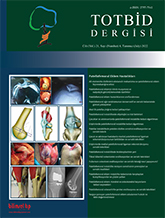
A detailed physical examination together with various radiographic imaging modalities are applied in combination to evaluate orthopedics and traumatology disorders of the patellofemoral joint clinically. Anterior knee pain is the most common complaint in patients consulted for patellofemoral joint problems. Besides, apprehension during motion of the joint or feeling of instability are commonly detected symptoms. Subluxation of the patella over femoral trochlea during flexion-extension with a relocation is defined as `J sign`. The most important finding of the patellar instability during the clinical examination is positive apprehension test. Weakness or atrophy of the medial part of the quadriceps muscle should also be examined and noted. Evaluation of the patellar height should always be kept in mind in patients with patellofemoral pain. On the axial view patellar radiograph, sulcus angle is defined as the angle between the lines drawn through the heighest points of the condyles and the deepest point of the trochlear groove. Beyond direct radiographs, computed tomography and magnetic resonance imaging also provide valuable information during clinical evaluation. In order to have a precise treatment approach to be established, detecting medial patellofemoral ligament injury as well as accompanying osteochondral lesions via magnetic resonance imaging in patients with acute patellar dislocation is crucial.